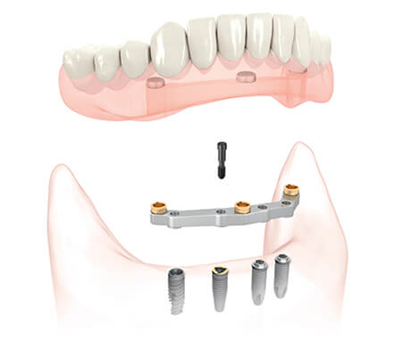Dental implants are designed to provide a foundation for replacement teeth that look, feel, and function like natural teeth.
Dental implants serve as the base for many types of tooth replacements. Implants can replace one tooth or several missing teeth with crowns or bridges that are fixed in place. For replacement of many teeth or all of the teeth, implants can support very secure removable dentures. Dental implants allow outstanding results in both appearance and function of replacement teeth.

A dental implant or implants are one of the newest and best advancements modern dentistry has to offer. Implants allow us to replace missing teeth, anchor fixed partial dentures or complete removable dentures, or even allow a person who is wearing complete dentures or is faced with wearing complete dentures to have a complete fixed dentition just like their own natural teeth before they were lost.
When describing a dental implant, the best comparison is to that of a natural tooth. The part of your teeth that you use to chew and that you can see is called the crown of the tooth. This crown is supported by the part of the tooth embedded in bone which is called the root. An implant is basically a replacement for the root of a missing tooth. When placed in your jaw, an implant becomes firmly attached to the bone. The cells in our bone have a strong affinity for the titanium in the implant, and during integration, the implant actually fuses to the bone. Once this process takes place (typically in 6 weeks to 6 months) we can use an attachment to the implant called an abutment to attach a crown, bridge, or denture to the implant.
When both the tooth and root are damaged beyond repair, the best permanent replacement is a single-tooth implant: a single unit combining a dental implant with a ceramic crown. Usually, the implant will also get a post or abutment screwed onto it to support the ceramic crown.
This solution both looks and functions just like a natural tooth. Often, depending on the patient’s mouth, an immediately functioning temporary tooth can be placed. This helps to create an excellent aesthetic result, with shorter treatment time and minimized pain.
If you are missing a tooth or teeth, or are faced with losing a tooth or teeth, dental implants may be the most natural tooth replacement available. Implants are rapidly becoming the restoration of choice for replacing missing teeth.
Dental implants can be the best solution for the person wearing complete dentures. As few as two implants may be placed and either a new denture fabricated or the existing denture retrofitted to attach to the implants. This allows a greater degree of stability and retention than ever possible with traditional complete dentures.
Alternative choices to implant dentistry include: cemented (fixed) bridges, removable partial dentures, a combination of fixed and removable, or complete dentures.
Depending on your situation, implant dentistry can be accomplished in 3 to 4 visits over the course of 6 to 8 months. More complicated case may take longer. Under the proper circumstances, a tooth can be placed on an implant the same day the implant is placed. Dental implants look and feel so natural, you may forget you ever lost a tooth.
Once an implant is placed, the biggest risk to its success is perio-implant infection, very much like periodontal disease. Continued care with our hygiene department is crucial to long-term success.
Very few dentists have the dual training and expertise to offer both restoration and replacement procedures. Implants are only as good as the dentistry they support. The end result must be determined before implants are placed.
Comprehensive treatment and planning are required. This includes the review of medical and dental histories, periodontal (gum) health, bone quantity occlusion, TMJ, and facial esthetics.
Photographs, dental models and X-rays are all analyzed first so that there is a clear vision of the final restoration.
Bone grafting is a procedure to gain more quantity of bone. If there is a deficiency, bone-forming or -enhancing products can be used during a separate visit or during the implant placement to strengthen the anchor point.
Implant supported bridges for more multiple missing teeth

Dental implants preserve bone and provide support to your new natural looking tooth. Unlike dentures, dental implants give you the same biting force as natural teeth, while dentures that are not supported by implants only provide about 10% to 20% biting force of natural teeth.
With dental implants, anyone who lost their teeth will regain the confidence in their smiles and will be able to eat anything, knowing that their new implant teeth looks natural and that their facial contours have been preserved.
Teeth implants are tiny posts made of titanium placed into your jawbone where teeth are missing. The bone bonds with the titanium post to create a strong foundation for the artificial teeth. Another reason to choose implants is that they help preserve facial structure, which in turn prevents the bone deterioration that naturally occurs when you have missing teeth.
Dental implants are modern day miracles that are changing the way people live! With implants, patients are now rediscovering the comfort and confidence to eat, speak, laugh and enjoy life.
Implant supported dentures for more stable, secure, and forceful biting




